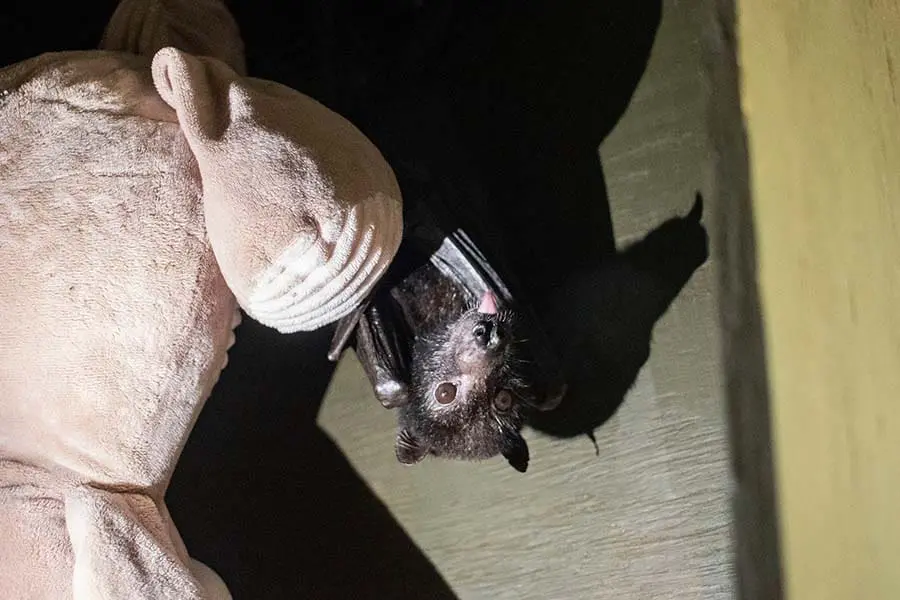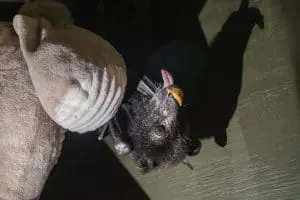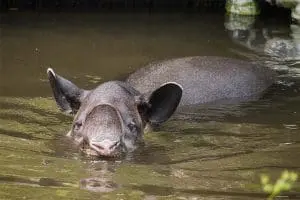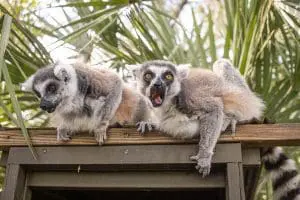

Flounder the small flying fox lives behind the scenes and snuggles (upside down) with stuffed animals.
Creating the right space to suit our animals requires time and effort. Our animal care team takes a lot into consideration when customizing habitats for our different animals, such as size, structures, water access, foliage, shade and more. Although every species at the Zoo resides in a custom habitat, we create “retirement homes” for some of our older residents, designed with their geriatric needs in mind.
We consider an animal “geriatric” once they reach around 80% of their expected lifespan. As part of our preventative approach to animal care, our older animal residents receive routine quality of life assessments, specialized diets, tailored medications, enrichments and adjustments to their habitat. So, what does a retirement home look like for our older residents?
A Quiet Condo for Flounder
 We have a Zoo resident that you may not even know about – Flounder the small flying fox! She is the only member of her species, and the only bat, to reside here and has lived at our Zoo since 2001. At 29 years old, Flounder has far exceeded her species’ median life expectancy.
We have a Zoo resident that you may not even know about – Flounder the small flying fox! She is the only member of her species, and the only bat, to reside here and has lived at our Zoo since 2001. At 29 years old, Flounder has far exceeded her species’ median life expectancy.
Due to her advanced age and nocturnal disposition, Flounder lives in a behind-the-scenes area of the Zoo. Her habitat is equipped with many special enrichment items like climbing structures to encourage her to be active, stuffed animals to keep her cozy, hideouts to give her options and a night house for daytime naps.
Underneath her night house is a climbing structure so Flounder can climb down with ease when she is ready to explore her space. Although she spends the daylight hours inside her house sleeping, keepers note that Flounder is very active at night! “We have seen video footage of her flying all around her habitat, exploring all of her enrichments,” said Animal Keeper Mallory Bourne.
A Lazy River for Josie
 If you’ve wandered through the Wild Florida section of our Zoo, you may have spotted one animal who may not inspire thoughts of the Sunshine State. Twenty-eight-year-old Baird’s tapir, Josie, lives in the deer yard and has access to the open water located just across from the bald eagle habitat. Although her species isn’t found in Florida nowadays, we found this space to be perfect for an older Baird’s tapir. She has access to many different areas, lots of water for swimming and opportunities to socialize with the area’s other residents if she so desires.
If you’ve wandered through the Wild Florida section of our Zoo, you may have spotted one animal who may not inspire thoughts of the Sunshine State. Twenty-eight-year-old Baird’s tapir, Josie, lives in the deer yard and has access to the open water located just across from the bald eagle habitat. Although her species isn’t found in Florida nowadays, we found this space to be perfect for an older Baird’s tapir. She has access to many different areas, lots of water for swimming and opportunities to socialize with the area’s other residents if she so desires.
Josie has been a Zoo resident since 1994. Over this time, she has lived with other members of her species in a few different areas of the Zoo. Most recently, she has been taking a vacation from her Wild Florida home to visit Baird’s tapirs Mia and her son in Rainforest Revealed. This comes as we work on introducing the two groups together in hopes they may soon be able to share a space! This means that in the future, Josie will be able to explore both habitats at her leisure.
A Quaint Crash Pad for Matilda and Kamots
 Have you kayaked with us through Expedition Africa? If so, you may have noticed we have not one – but two islands that house our lemurs! If you look off the Africa platform extension to the lemur habitat, look just to the right and you’ll spot a smaller island, which we lovingly refer to as “Little Madagascar.” On this island live two of our ring-tailed lemurs, 28-year-old male Kamots and 15-year-old female Matilda.
Have you kayaked with us through Expedition Africa? If so, you may have noticed we have not one – but two islands that house our lemurs! If you look off the Africa platform extension to the lemur habitat, look just to the right and you’ll spot a smaller island, which we lovingly refer to as “Little Madagascar.” On this island live two of our ring-tailed lemurs, 28-year-old male Kamots and 15-year-old female Matilda.
Kamots and Matilda are not a breeding pair, but they sure do enjoy each other’s company. They can often be found hanging out right beside each other! Their island has been adapted to suit their needs with lower-hanging vines and lowered night houses that they can easily access.
Although this is not an expansive list of the “retirement homes” our Zoo offers to its residents, these three examples highlight just how much thought goes into providing appropriate homes for our older animals. Other residents who live in retirement homes: Pepper the cheetah, Pete and Sapphire the siamangs and Makina and Fancy the Visayan warty pigs.
Taking care of animals is a lifelong commitment, no matter the species. Here at the Zoo, we strive to provide the best possible care for the entirety of all our animals’ lives, including those who have surpassed their median life expectancies. Next time you’re at the Zoo, see if you can spot some ways in which an animal’s habitat is modified to fit their size, age or species needs!
Brevard Zoo is an independent, not-for-profit organization that receives no recurring government funding for our operating costs. Your generous support enables us to continue to serve our community and continue our vital animal wellness, education and conservation programs.